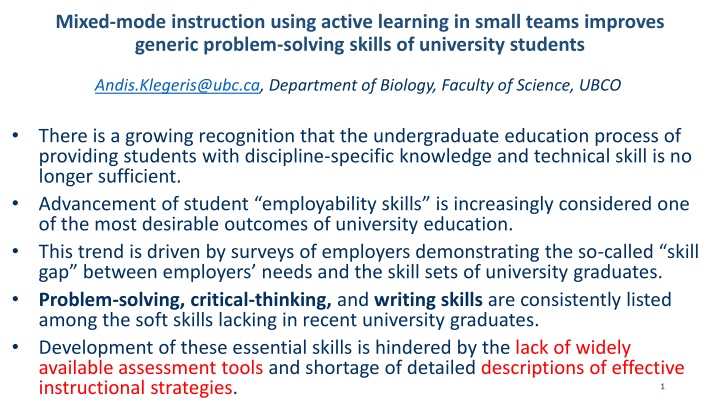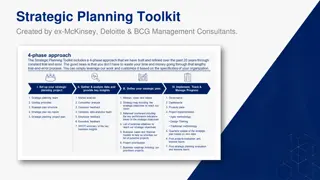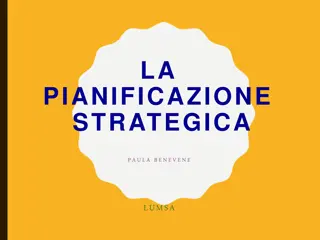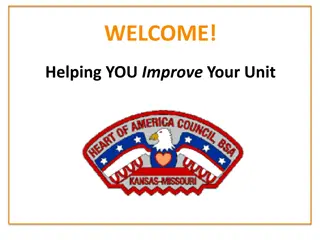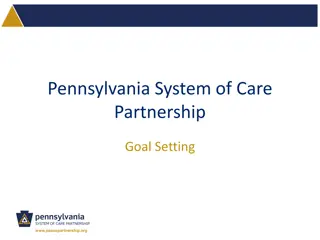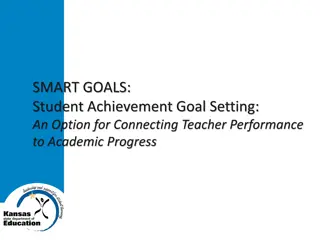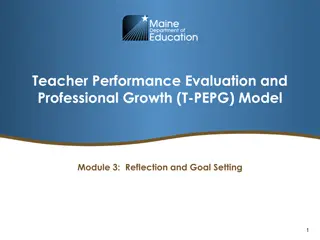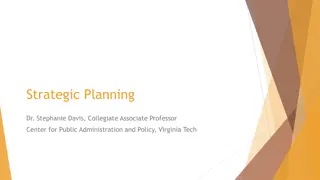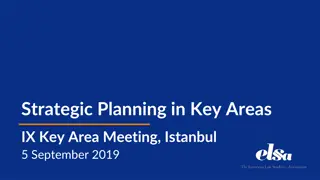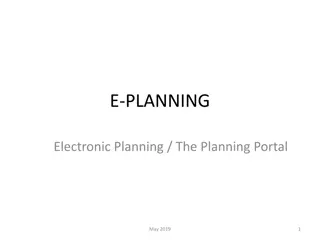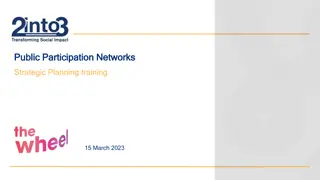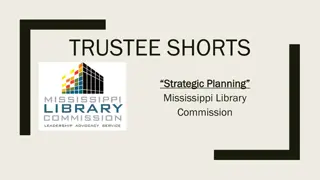Individual Goal Setting and Strategic Planning
This content emphasizes on individual goal setting, choosing a strategy to achieve it, organizing into groups, articulating strategies, identifying necessary resources, planning assessments, and navigating the politics involved. Strategies such as Peer Instruction, Whiteboards, Simulations, and more are explored to enhance learning outcomes.
Download Presentation

Please find below an Image/Link to download the presentation.
The content on the website is provided AS IS for your information and personal use only. It may not be sold, licensed, or shared on other websites without obtaining consent from the author.If you encounter any issues during the download, it is possible that the publisher has removed the file from their server.
You are allowed to download the files provided on this website for personal or commercial use, subject to the condition that they are used lawfully. All files are the property of their respective owners.
The content on the website is provided AS IS for your information and personal use only. It may not be sold, licensed, or shared on other websites without obtaining consent from the author.
E N D
Presentation Transcript
Mixed-mode instruction using active learning in small teams improves generic problem-solving skills of university students Andis.Klegeris@ubc.ca, Department of Biology, Faculty of Science, UBCO There is a growing recognition that the undergraduate education process of providing students with discipline-specific knowledge and technical skill is no longer sufficient. Advancement of student employability skills is increasingly considered one of the most desirable outcomes of university education. This trend is driven by surveys of employers demonstrating the so-called skill gap between employers needs and the skill sets of university graduates. Problem-solving, critical-thinking, and writing skills are consistently listed among the soft skills lacking in recent university graduates. Development of these essential skills is hindered by the lack of widely available assessment tools and shortage of detailed descriptions of effective instructional strategies. 1
Evidence Evidence- -based pedagogy based pedagogy Passive Active learning learning Hypothesis: Introducing problem-based learning (PBL) where small teams of students work on ill-structured problems, as well as workshops based on groupwork, leads to improved generic problem-solving skills of students. Use of flipped classroom with ~1/3 of class time spent on PBL. Gradual transformation over seven years. Tutor-less groups of 7-9 students in standard lecture theatres or fully remote (up to 100 students). In-class periods 2009 2018 In-class periods 2009 2018 January, week 1 January, week 1 Introduction Lecture Introduction Introduction Introduction Week 1 Workshop Week 1 Lecture Workshop Week 2 Week 2 Lecture Lecture PBL 1.1. Guest Lecture Week 2 Week 2 Lecture Lecture PBL 1.1. Guest Lecture Week 3 Lecture PBL 1.2. Week 3 Lecture PBL 1.2. Week 3 Lecture Guest Lecture Week 3 Lecture Guest Lecture Week 4 Lecture PBL 1.3. Week 4 Lecture PBL 1.3. Week 4 Lecture Workshop Week 4 Lecture Workshop February, Week 1 February, Week 1 Test 1 Lecture Test 1 Test 1 Test 1 Week 1 Workshop Week 1 Lecture Workshop Week 2 Lecture PBL 2.1. Week 2 Lecture PBL 2.1. Week 2 Lecture Guest Lecture Week 2 Lecture Guest Lecture Week 3 Lecture PBL 2.2. Week 3 Lecture PBL 2.2. Week 3 Lecture Guest Lecture Week 3 Lecture Guest Lecture Week 4 Lecture PBL 2.3. Week 4 Lecture PBL 2.3. Week 4 Lecture Study time Week 4 Lecture Study time March, Week 1 March, Week 1 Lecture Test 2 Guest Lecture Lecture Guest Lecture Week 1 Test 2 Week 1 Test 2 Test 2 Week 2 Lecture Guest Lecture Week 2 Lecture Guest Lecture Week 2 Lecture PBL 3.1. Week 2 Lecture PBL 3.1. Week 3 Lecture Guest Lecture Week 3 Lecture Guest Lecture Week 3 Lecture PBL 3.2. Week 3 Lecture PBL 3.2. Week 4 Lecture Workshop Week 4 Lecture Workshop Week 4 Lecture PBL 3.3. Week 4 Lecture PBL 3.3. April, Week 1 April, Week 1 Lecture Final exam 4th year biochemistry courses Workshop Lecture Workshop Test 3 Final exam Test 3 2 Klegeris and Hurren (2011) Adv. Physiol. Educ. 35:408-15
Advancing generic problem-solving skills (PSS) Klegeris et al., 2013 CBE Life Sci. Educ. 12:73 9 Klegeris et al., 2019 High. Educ. Res. Dev. 38:1432 44 Designed a PSS testing tool: Already established questions: selected from the item bank of PISA (OECD, 2004) Short: 15 minutes Generic problem-solving skills: can be solved by students from different programs Two versions of the test: allow monitoring student progress Quick to mark: simple answer key No cost: available by contacting andis.klegeris@ubc.ca Student cohorts (year) Students writing both versions of PSS tests % partici- pation January average standard deviation (out of 13) April average standard deviation (out of 13) Change (out of 13) [%] P (paired Student s t- test 2018 2019 43 46 89 98% 98% 98% 8.66 2.48 8.25 2.69 8.48 2.56 9.65 1.79 9.22 2.37 9.45 2.09 0.99 [11.4%] 0.97 [11.8%] 0.97 [11.4%] 0.007 0.006 0.001 2018, 2019 combined Online test 2020 12 17% 8.38 3.03 9.46 2.36 1.09 [13.0%] 0.23 3
Conclusion 1 Introducing active learning in small groups leads to significant improvement of the generic problem-solving skills of 4th year students. Online pivot: Students adapted well to the online environment and were able to self-organize, problem-solve, and successfully conduct PBL tutorials unsupervised. The generic problem-solving skills testing tool used detects a 11-12% improvement in the test scores in groups of 43+ students. Online pivot: Online administration of the test to a smaller group of students (12) generated a data set similar to those obtained through in-class testing, but further optimization studies will be needed before this test can be administered online. This study describes one instructional strategy that can help students advance their generic problem-solving skills, as well as a testing tool that can be used to monitor effectiveness of such strategies. 4
Activity Content test score Peer mark Problem- Pearson s correlations of scores solving test score Content test score 1 Individual scores (%) obtained by seven different students [quartile] Peer mark 0.33 1 Problem- solving test score 0.20 0.10 1 Student Course content test average (N = 3 exams) Peer mark average (N = 3 peer evaluations) Problem-solving test average (N = 2 tests) A B C D E F G 91 [4] 53 [1] 78 [3] 89 [4] 82 [4] 52 [1] 52 [1] 88 [4] 68 [1] 87 [4] 87 [4] 75 [2] 81 [3] 82 [3] 98 [4] 63 [1] 88 [4] 83 [3] 23 [1] 88 [4] 67 [2] 5
Conclusion 2 Multi-dimensional student evaluations are superior to any uni-dimensional testing: inform students about their strengths and areas requiring further improvement. It is important to develop and improve assessment techniques of employability skills, including the generic problem-solving skills, which are highly valued by a broad range of employers. 6
